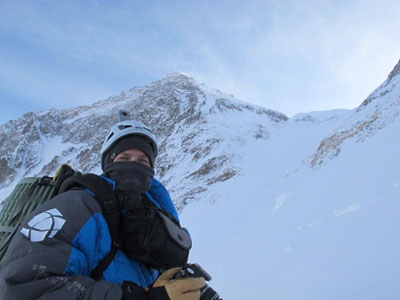|
A near-death experience on Mount Everest
 |
Zach Urness/Daily Courier
Brian Dickinson on Mount Everest. |
A 1992 Rogue River High graduate reached the summit of Mount Everest, but nearly died multiple times on the descent after he was blinded and ran out of supplemental oxygen. o o o oBy Zach Urness of the Daily CourierRogue River High graduate Brian Dickinson reached the summit of Mount Everest this past Sunday on a solo climb that nearly took his life multiple times. The former U.S. Navy search and rescue swimmer reached the 29,035-foot summit around 5:30 a.m., but because of serious damage to his eyes — caused by high-intensity sunlight after his goggles broke — he descended from the world's highest point almost completely blind. He nearly fell to his death twice while following fixed lines down the mountain. A small avalanche dropped out below Dickinson, and he tumbled head-over-heels until the safety rope loaded and saved his life. Dickinson is headed home from Bangkok to his wife Joanna and two children in Snoqualmie, Wash., but there were times when it wasn't certain he'd ever see them again. Perhaps the worst moment took place at 27,500 feet. Almost completely blind and in one of the most hostile environments on earth, Dickinson hadn't slept for more than 30 hours when he ran out of supplemental oxygen. "It's really tough to breathe up there, even if you're acclimatized to the altitude," Dickinson said in an email from the Bangkok Airport. "It was probably the most scared I've ever been in my life. The route has fixed lines, so I knew I could remain connected and find my way down. I just couldn't panic ... wasn't an option." Dickinson eventually reached an extra bottle of oxygen left behind by his climbing partner, Pasang Temba, a climbing Sherpa who had turned back before reaching the summit because of sickness. The supplemental oxygen gave Dickinson enough energy to rappel from 27,500 feet down the icy, steep pitches that led to South Col camp at 26,000 feet. "I was staggering and hallucinating," he wrote in his blog for the website climbing.com. "I thought the rocks were people and walking toward me. Then for a moment I thought, 'Did I die up there? Is this heaven? If it is then it kind of sucks since I'm still wearing all this heavy gear and walking on an ice field.'" A few moments later, Pasang found Dickinson staggering through the snow, gave him extra oxygen and led him to a tent. Dickinson’s inability to see was caused by what’s called snow-blindness or Photokeratitis. At around 24,000 feet, he dropped his goggles and broke them, and was unable to use them to protect himself from intense exposure to UV light caused by the sun reflecting off the snow and such high altitudes. When Dickinson woke up at South Col the next morning his eyes still were swollen shut, but since it was crucial to get him below the Death Zone — where the altitude literally begins to break down the human body — he headed for Camp II at 21,500 feet. Aided by Pasang and his friend Dennis Broadwell, Dickinson blindly navigated some of the most dangerous terrain on earth. He rappelled the notorious Lhotse Face (extremely steep and icy) and crossed the Khumbu Ice Fall on ladders tied together across massive crevasses in the ice. On Tuesday, he reached Mount Everest base camp and started to recover some of his eyesight. By Thursday, Dickinson made it to Bangkok, where he'll fly home in time for his wife's birthday next week. It was a promise he made nearly two months ago when he set out for the Himalayas. "I talked to him on the satellite phone when he was still on the mountain, and he was pretty emotional because he was still blind and really felt like he'd had a close call with death," his wife, Joanna, said. "But he's going to make it home in plenty of time. And really, even in the worst moments, I always knew he would." Note: Dickinson made it home this past night, and will be meeting with eye doctors, as he still has some damage that hasn't quite healed yet. ... He's now finished four of the seven mountains in his quest to climb the “Seven Summits” — the highest peak on each continent. o o o o May 21, 2011
| 




